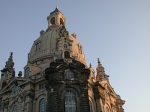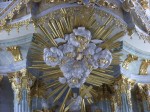I’ve been living in the city of Dresden, capital of the province of Saxony in Germany, for the past 3,5 years. I fell in love with it when I first came here back in the summer of 2006, in my second year as a BA student, to make my internship at the Asian Department of the Porcelain Collection here.
If you google for pictures of the city, you will be amazed by its baroque architecture and I can assure you that the first time I experienced the famed Canaletto View, I was absolutely stunned, and shivers were coming down my spine, because I had never seen anything quite as impressive, imposing and straightforward beautiful.
However, there was a catch to it all that I didn’t know at the time. On March 13th, 1944 the first wave of the most controversial raid of the Royal Air Force and the United States Army Air Force created a moonscape of what was once a center of culture and the arts, killing some 100,000 civilians in the process. Ironically, none of the possible military targets were targeted. Destroyed were only the churches, palaces, museums and the opera.
This is what was left:
View from the tower of the City Council after the bomb raids
Source: Wikipedia
Since this had been a raid the people of Dresden had expected, they managed to get most of the enormous art collections, including ancient Chinese and Japanese porcelain, Fine art with a worldwide cultural importance, Ancient sculptures and all kinds of other object, out of the city. Thus, most of them were saved from the cruelty of the unjustifiable raids against human culture. Unfortunately, Dresden was then ‘saved’ by the even less tolerable Red Army, which brought Communism and everything ‘wonderful’ that came with it. It also stole everything it could, including most of the art objects once housed in the city and brought it to the USSR as spoils of war. Under the Communist oppression, not much was done to repair the city. Repulsive communist architecture sprawled throughout it and they barely managed to repair the famous Zwinger and parts of the Kings Residence.
Communism fell in 1989, the Russians returned the stolen pieces of art or most of them anyway, and the people decided it was now time to bring beauty and splendor back to their city. I will not talk about every individual building, of course. I will illustrate this with one I like in particular – the favorite church of every Dresdener. It had been built from 1722 to 1743 from sandstone by George Bähr to replace an older, not as imposing church at the New Marketplace in the city. It is famed for its round shape and, most of all, for its dome, built entirely with stone, which – at the time – was considered impossible.
Frauenkirche at the beginning of the 20th century
Source: www.frauenkirche-dresden.de
During the raids I mentioned, the church was somehow missed by all the bombs and bullets. However, as fires spread throughout the city, it was not left out and on February 14th the blocks of sandstone started falling apart because of the heat. On February 15th, the stone dome fell under its own weight of some 12,000 tons and destroyed the entire building.
Fruaenkirche after the raids
Source: www.frauenkirche-dresden.de
After Communism fell and religion and culture stopped being a taboo, the people of Dresden started a charitable organization that was supposed to rebuild the entire church exactly as it had been before its destruction. The ruins were searched thoroughly; every block of stone that was still in a good shaped was numbered and placed around the site; every picture and all the remaining plans of the church were studied carefully. In 1995 the rebuilding started. All the old stone blocks were used at the places they occupied in the old building. Every fresco was painted exactly the same way it had been before. Even the impressive church organ was built as an exact copy of its predecessor. Everything was restored to its former glory down to the tiniest detail. And each and every step of this procedure was financed entirely by private donations. And, finally, the church was finished in 2005.
Detail of the rebuilt church with part of the remaining choir space
Detail from the altar as it is today
Source: www.frauenkirche-dresden.de
Now, to me, this is even more impressive than the grandeur of the building itself, more stunning than the beauty of its frescoes, more imposing than the grace of its silhouette and of every wonderful little detail, that comprises the whole of it.
It is absolutely inspiring to witness such a testimony of the human spirit and of cultural consciousness as a whole. It is truly incredible how powerful cultural traditions can be. The Frauenkirche or Church of the Holy Lady, in Dresden is exactly this - all the buildings that surround it, too. Come and see it yourself. I assure you that you will be as impressed as I was, when I was just standing there, in the rain, my mouth wide open, on this cold May evening some 5 years ago.





